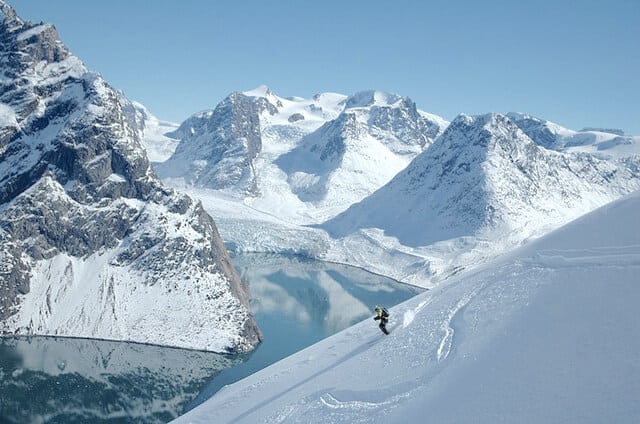
For some, skiing lap after lap of your favoured high-speed chair-lift – trying to find a new way to ski the same tired descent – has lost its thrill.
Perhaps it’s because you’ve been skiing so often, holidaying or working in the same resort so many times, that skiing the marked runs of the same mountain is no longer a challenge.
Maybe you’re simply looking to find that thrill that you once had, hoping to recreate the excitement that came from becoming an advanced skier for the first time.
Sound familiar? Then perhaps it’s time you tried heli-skiing.
Is Heli-Skiing For You?
“If you love to ski or snowboard, there is nothing better than heli-skiing. It’s that simple,” writes Larry Olmstead, a ski enthusiast and Guinness World Record holder for Most Trails Skied in 8 Hours. “No lift lines, or lifts for that matter – forget cold chair-lift rides, with the helicopter you can go from the ground to the top in a couple of minutes, while experiencing the kind of views people pay hundreds of dollars for on sightseeing flights.”
Heli-skiing is a skiing experience like no other, as I discovered last winter on a trip to Verbier. Originating in the 1950s, it was a way for brave souls to access the best and most remote ski locations year-round by helicopter, often miles away from the tamer groomed slopes of ski resorts.
Today heli-skiing is big business – and with good reason. The powder in and around popular heli-ski drop zones is often untouched and the vistas from these unskied mountain peaks can be thrill-inducing. The fact that, once the chopper leaves, there’s only half a dozen of you as far as the eye can see only adds to the excitement.
But it doesn’t come cheap on any level. Even at the entry level it can be dangerous (part of the reason why it’s banned in most of the Alps, Switzerland being an exception), labour intensive and expensive.
Before rushing to book a week’s heli-skiing in the Canadian wilderness, a good place to start is with one day’s heli-skiing whilst on holiday in a ski resort. At £300 (426€) per person for a single drop with Verbier’s Adrenaline Guides – which typically translates into two to three hours of skiing – this is not a hobby for the average ski bum. Around £4,000 (5,698€) – plus international flights – for three days in a lodge in Canada is even more eye-watering.
But get it right and boy, is it worth it.
First, A Clarification…
Unlike the movies, heli-skiing doesn’t involve launching yourself 20 feet (6m) from a moving helicopter into neck-deep snow, complete with a dramatic backflip on the way down. Unless you’re James Bond, then the type of heli-skiing you’ll experience won’t involve any freefall from a moving helicopter.
If that leaves you sighing with relief, great – it’s bizarre how widely held the belief is that this is what heli-skiing involves.
On the other hand, don’t be disappointed if you had your hopes set on hopping out of a hovering chopper. It’ll be an amazing experience nonetheless; one that will leave you feeling like you have just been, quite literally, on top of the world.
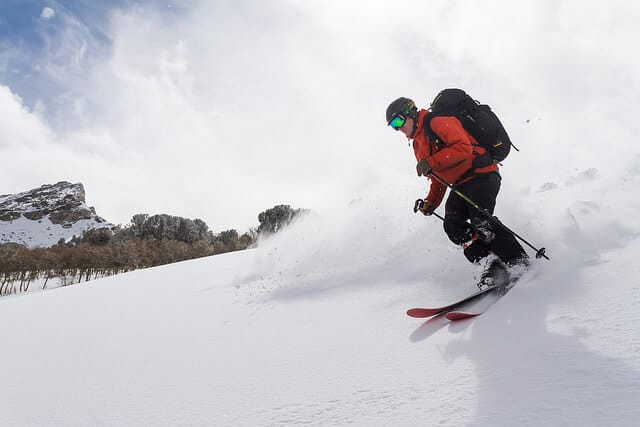
Seven Ways to Survive Your First Drop
By now I’m sure you’ve no doubt what an excellent way this is for experienced skiers to enjoy the excitement of skiing off-piste. But in order to help you to make the most of your heli-skiing adventure, here are some tips and suggestions to help you have a safe and exciting time…
1. Choose the Right Location
Choosing the right location can make or break your heli-skiing trip. Be sure to research what the terrain is like in your location of choice. This will give you an idea about what you can expect and will help you to practice skiing in different types of terrain in order to prepare for your trip.
Next, select your resort. All but the most bottomless of wallets will have make do with heli-skiing on one or two days of an extended trip, and so it’s important that you make sure your resort base is a good one. After all, helicopter flights rely on good weather – if you’re unlucky enough to have your flight cancelled due to bad weather, you want to still be able to have a good ski.
Verbier is a good base, but there are plenty of great options out there. Bear in mind that Switzerland and Italy are the only countries in the Alps where heli-skiing is legal, so if you aren’t basing yourself in either it’ll have to be somewhere with good access over the Italian or Swiss border, like Chamonix. Some good information on European heli-ski locations can be found in this article on powderhounds.com.
2. Get in Shape
Fitness is key. It’s more important to be in good shape than to have perfect carving technique. While you should be able to go on black runs without any hesitation, your stamina and agility are important for having a good time.
Being fit can help you to stay safe during your trip, and in some cases, can even help to prevent certain types of injuries. Heli-skiing takes a lot of effort and even some good skiers may not be in ideal shape to ski for over two hours, potentially with an extended hike or short climb in the middle.
3. Travel Light
Most tour guides and operators will bring along extra gear that you’ll need to have a successful trip. With that being said, you should bring the gear you are told to bring, which will most likely include your normal ski gear, helmet, boots, skis and of course – camera.
Keep in mind there is a weight limit on most helicopters, so anything that you bring that is considered to be ‘extra’ will be left behind. In other words: if bringing large speakers up the mountain to blast out your favourite tunes is ever appropriate, this isn’t one of those times.
Don’t forgo the important things, though, and remember to bring plenty of water!
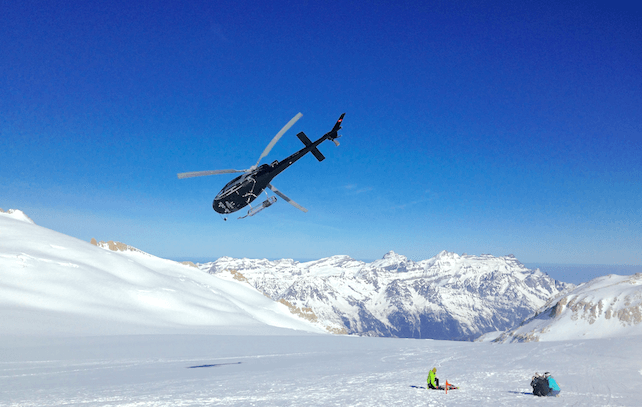
4. Have Experience In Deep Snow
Inexperienced skiers suffer almost three times more injuries than more experienced participants. Before you head out, make sure you’re experienced enough to tackle the uncharted slopes. It’s important to be at the advanced intermediate level skier before you attempt heli-skiing.
It’s also important to know about deep snow. Deep snow can be dangerous if you don’t know what you’re doing. Since heli-skiing often involves skiing in deep or soft snow, you should learn how to ski in these conditions so they won’t catch you off guard.
You should also learn how to put your skis back on in if they come of in the deep snow because chances are you will lose a ski and need to know how to put it back on.
5. Get to Know Your Guide
Choosing a guide that’s reputable and knows what they’re doing is an important part of having a safe trip. While most guides are good at what they do, it’s still a good idea to check their references and credentials.
Getting to know your guide can also help you feel more relaxed and at ease, and will help you have a safer, more enjoyable time.
6. Ask Questions
Don’t be afraid to ask your instructor or guide questions. If you see a pitch that looks like it would be fun to go down, ask about it. Your guide will let you know what is safe and what isn’t safe – and you will leave feeling like you got the most out of your ski trip.
Asking questions is also a great way to learn about your surroundings, which can in turn help you to stay safe while you’re out on your ski trip.
7. Slow Down
This isn’t a race, nor is there any need to show the rest of your group how good a skier you are. Heli-skiing is expensive, so savour it – if you’re feeling pressured into going faster than you want, slow down. If you feel that you are being rushed, ask your guide if there’s a need to hurry. It’s highly unlikely that there will be.
Slowing down will help you make more tactical decisions about your skiing, avoid falling, and give you the time to relax and soak in the incredible mountain vistas around you.
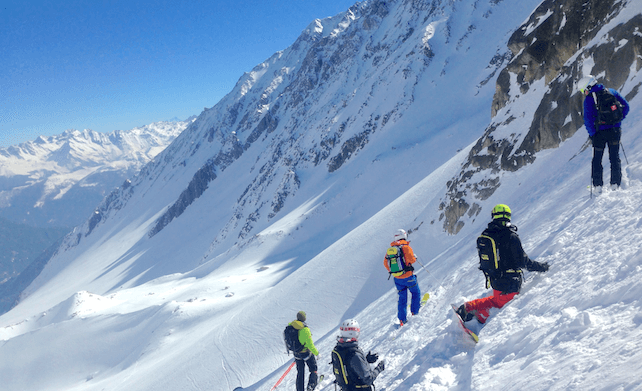
Over to You
Finally, remember to enjoy yourself! A heli-skiing trip, no matter if it’s your first, tenth, or hundredth – can give you a thrill unlike any other.
Enjoying yourself, and remembering these tips will help you enjoy every minute of your trip – flying down untouched mountains, taking in breathtaking scenery.
Heli-skiing in Verbier is available with Adrenaline Guides. Whilst Verbier is known for being one of the more expensive resorts in Europe, three-star Hotel Montpelier aims to buck this trend with double rooms from £132 (187€) including breakfast, and its own ski rental shop and indoor pool.
For more on the subject, including where in the world to do it, see Arnie Wilson’s feature Where to Go Heli-skiing.











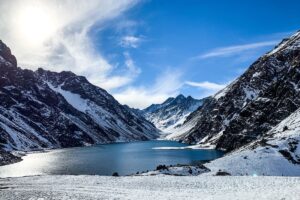

Heli Skiing is an expensive and untouchable dream for me.
Find some fresh powder early morning in your resort (any resort) and you can have the thrill of first tracks, although it will probably be over by lunch.